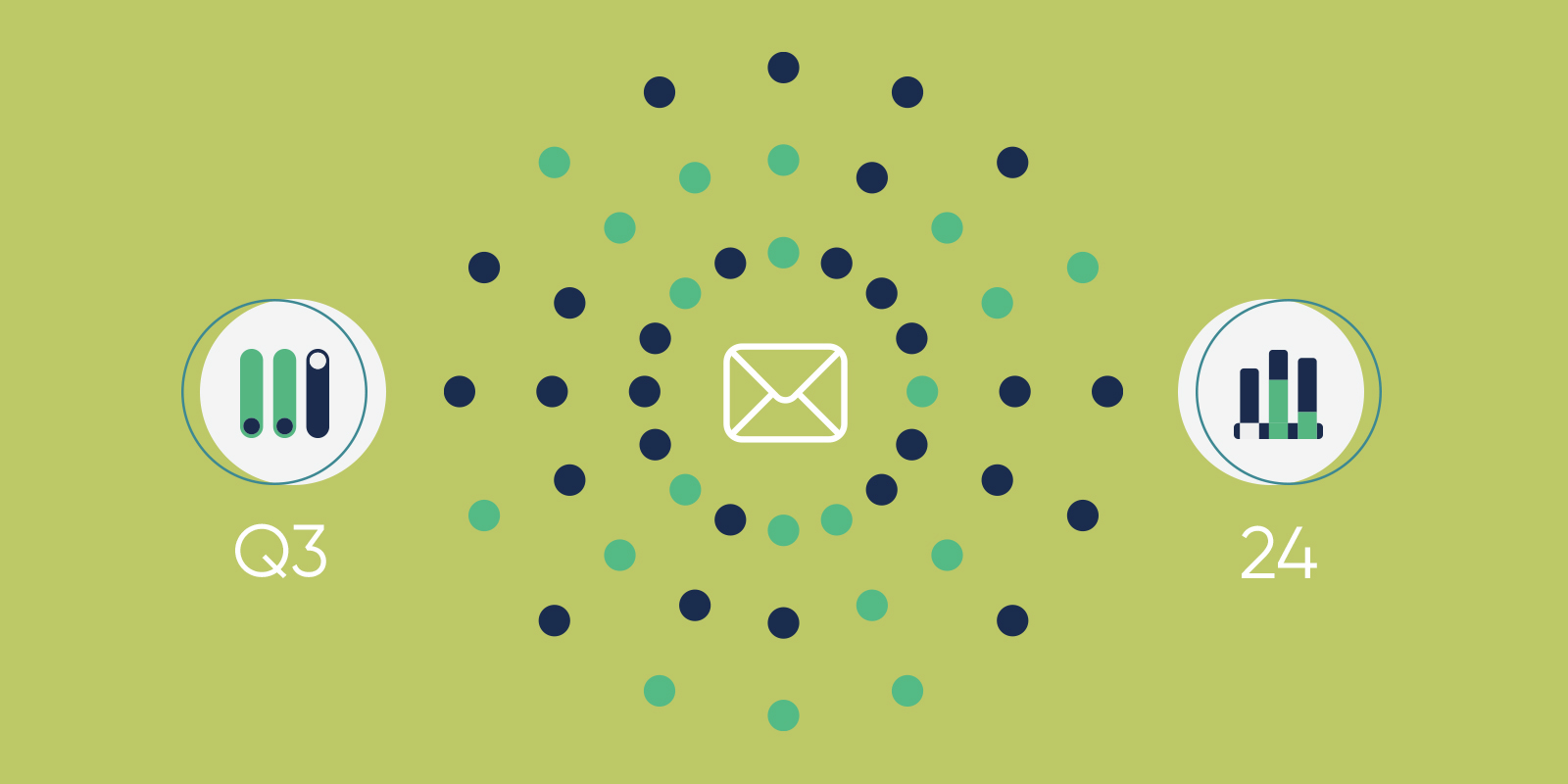
Every quarter, we compile aggregate email engagement stats from our media industry clients so you can see where your email marketing performance stacks up, compare yourself to your peers and plan campaigns with confidence.
This quarter, we’re breaking down data from nearly 2 billion emails sent from Omeda’s integrated audience data platform during Q3 2024.
Here’s what you can expect in our report:
- A look at this quarter’s average open, click and click-through rates
- A performance breakdown for each deployment type
- Tips for mitigating subscriber fatigue as the newsletter industry gets more saturated, including examples from legacy media, indie newsletters and other senders like you
Read on to see what’s driving email engagement this quarter and beyond:
Overall quarterly performance change
- # of email deployments: 1,924,793,985, -3.01% from Q2 2024
- Delivery rate: 98.92%, compared to 99.02% in Q2 2024 (-0.01% relative, -0.1% absolute)
- Total open rate: 43.90%, up from 43.23% (+1.55% relative, +0.67% absolute)
- Unique open rate: 30.15%, compared to 30.10% in Q2 2024 (+0.17% relative, +0.05% absolute)
- Total click rate: 2.18%, down from 2.29% in Q2 2024 (-4.80% relative, -0.11% absolute)
- Unique click rate: 1.27%, down from 1.46% in Q2 2024 (-13.01% relative, -0.19% absolute)
- Total CTR: 4.96%, down from 5.30% in Q2 2024 (-6.42% relative, -0.34% absolute)
- Unique CTR: 4.22%, down from 4.83% in Q2 2024 (-12.63% relative, -0.61% absolute)
- Unsubscribe rate: 0.091%, no change from Q2 2024
- Complaint rate: 0.005%, no change from Q2 2024
(Some quick methodology notes: To capture the change between quarters more accurately, we report both the relative and absolute percentage change for each metric. We use the percent change equation to find the relative change between rates. We calculate the raw difference between the new and old percentages to find the absolute change. Also, all references to “click rate” and “CTR” in this report refer to the average unique click rate and average unique CTR among all delivered emails from Omeda.)
In Q2 ‘24, open rates across all deployment types declined, which we attributed partly to worsened inbox placement caused by changes to inbox service providers’ sorting algorithms. This seems to have stabilized, for now, as open rates stayed steady in Q3 2024.
However, the overall unique click rate dropped by 13% this quarter. That’s likely because the average click rate for promotional emails dropped by about 34% between Q2 and Q3 2024, from 0.85% in Q2 to 0.56% in Q3.
These emails comprised nearly one-third of all emails sent through Omeda this quarter, so it makes sense that their underperformance would pull down the overall average. (Although it’s worth noting that the click rate dropped for every deployment type this quarter.)
So why was there less engagement with promotional emails, specifically, this quarter? There’s no single answer, but we’ve got some theories.
Seasonality: We can attribute some dropoff to the summer lull, which is more likely to impact promotional emails than newsletters. Sure, everyone’s checking their email less often during the summer. But someone on summer vacation’s more likely to read the New York Times newsletter than your nurture campaign.
Subscriber fatigue: Some of this decline could come down to email fatigue. That’s especially true if you haven’t updated your automations, refreshed your marketing segments or cleaned your list for inactive subscribers. (Take this as your reminder to clean your list!)
Worse inbox placement: By definition, promotional emails are more likely to be sent to your audience’s promotional folders than other kinds of emails, like the newsletters that your audience reads in depth. Further, your audience is less likely to fish a marketing email out of their secondary folders than they would the newsletter they read every other week.
So, we’d expect to see open and click rates for promotional emails be the most impacted by algorithmic changes.
These algorithms are only going to become more sophisticated and stringent going forward, too. So just cleaning your list every quarter and segmenting by demographic won’t be enough to get conversions anymore.
You need to create multi-dimensional segments to target individual use cases. You need to customize your content to each individual’s buying journey. And you need to maintain an ideal list of health throughout the year. Fall short, and you won’t just lose revenue. Your inbox placement will suffer — and you’ll lose the chance to reach your audience at all.
The solution to all of these challenges? Double down on understanding your audience, collecting first-party data, and using it to deliver better audience experiences. We’ll address all three of these challenges next.
10 steps to stop subscriber fatigue before it starts
Newsletters have become one of the most important revenue drivers for media companies. But with more money has come more competition.
That’s making readers more selective, and they’re unsubscribing from excess content in favor of higher-quality, value-driven newsletters. So going into 2025, how can you cut through the noise and keep your audience engaged? Read on for expert-backed ways to mitigate subscriber fatigue and maintain audience interest:
Perfect your fundamentals
In the panic to keep subscribers engaged, it’s tempting (and frankly, more fun) to over-index on big swings — like redesigning the newsletter or chasing new sponsors. But in many cases, you’re better off reprioritizing and perfecting their fundamentals — like deliverability, list health, audience-first content, etc.
So before implementing major changes, review your performance and make sure you’re following email best practices. Some quick fixes includes:
Resolve deliverability issues right away: Are your deliverability rates below 95%? If yes, you’re probably getting sent to your audience’s spam folders. So don’t press go. Don’t collect $200. Go directly to your email service provider to see how you can improve your sending reputation and inbox placement. To prevent deliverability issues, clean your list at least quarterly, if not monthly, and follow these best practices.
(Note: Some email providers like Omeda provide built-in deliverability monitoring and support so you can a) prevent most deliverability issues and b) resolve any problems that may arise).
Audit your content. Take a look at the articles you’re linking to within emails. Are certain topics beginning to underperform? (To make this easier, tag each of your articles by topic, knowledge level, etc., so you can run a query on performance for each tag.)
Review your email engagement data to identify the best send times and dates for your audience. Audience preferences shift, and your sending cadence needs to shift in kind. So if your performance is dropping off, retest different send times and days.
Check in on your automations, like your welcome or re-engagement campaigns. Since these run more frequently than any one newsletter or promotional email, underperformance here will have an outsize effect on your deliverability and overall email health.
Review your automation performance and watch off for signs of drop-off throughout the campaign lifecycle. Some other questions to ask:
- Do your open and click rates fall off a cliff halfway through the series? If so, consider shortening your series.
- Do certain articles within your welcome series get more clicks than others? Review link performance within individual emails of your campaign, then swap out underperforming articles — or use dynamic content blocks to surface personalized recommendations for each reader.
- Do you have a process for removing subscribers from campaigns once they meet the designated goal or they show signs of email fatigue? If not, you risk alienating your subscribers and hurting your deliverability.
Reduce friction by balancing external links with zero-click newsletter content
Most newsletters list a series of articles/resources, then link out to the website or external sources. This makes sense in theory: You can distribute content you’ve already created, while driving traffic back to your site and getting click data to inform your strategy.
But that adds friction to the user experience. And taken too far, it keeps your audience from actually getting anything out of your newsletter.
For instance: Imagine a standard newsletter with six blocks that link to other articles. To get any value from that issue, readers need to click several links, read the linked article in a new tab, navigate back to the newsletter to keep reading, then do it again… and again. That’s not a sustainable model, especially if your audience is reading on mobile.
That’s not to say that you shouldn’t link out to anything else within your newsletter. Instead, balance external links with zero-click content — information that exists on its own within the newsletter.
For example, Send it Right, an email deliverability newsletter by Lauren Meyer, includes articles right within the newsletter. Subscribers get everything they’re promised without navigating elsewhere. That doesn’t just maximize engagement, it also lets Meyer position the newsletter as an important information source in its own right — not just a promotional channel for her website.
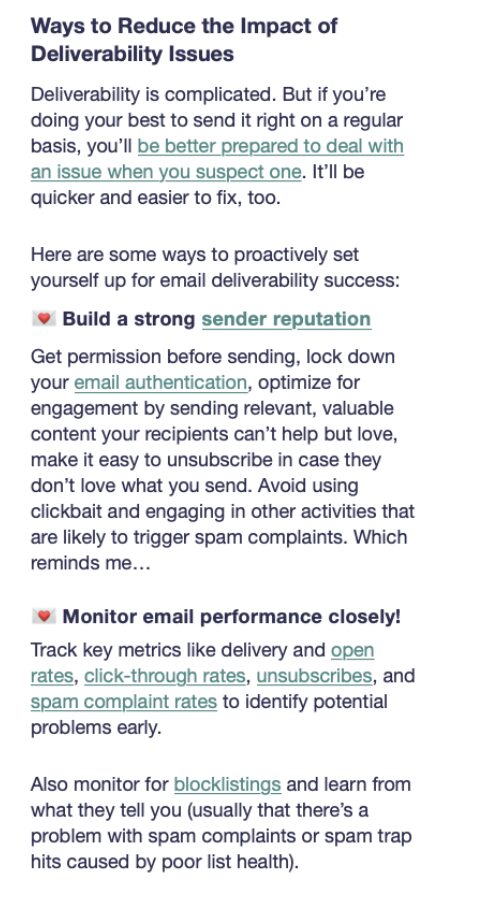
The Morning Shakeout, a running newsletter by Mario Fraioli, still does the link roundups common in other newsletters. But Fraioli adds significant clarity and context to each story he mentions, so the readers get a general idea of a) what it is and b) why it matters, even if they don’t click out to read more.
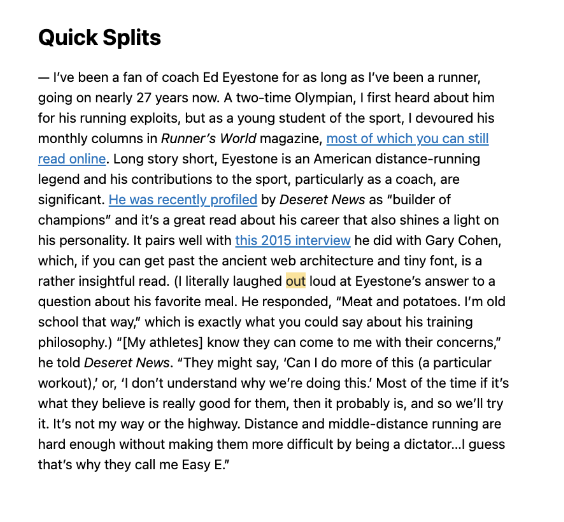
Allowing people to read some, if not most, of your newsletter within the message itself keeps your audience engaged and lowers the chance that they’ll get distracted by other apps/messages on their phones.
Conduct deep dives on specific topics through newsletter courses or special interest editions
Say that you’ve got a meaty new topic to cover, like an election, the Olympics, etc. Maybe you’ve done extensive reporting, you’ve got a lot of data to share, or it’s just an incredibly broad topic.
If you shove it all in your newsletter, you risk turning away audience members that are only kind of interested in the topic. (“Ugh, this is their 4th straight newsletter about first-party data. Time to unsubscribe!”)
But if you’ve done your research, part of your audience will find it valuable – and could even pay for it. (“X Newsletter is giving me the tools I need to get buy-in for a first-party data strategy at my company! This is going to get me a raise!”)
So how can you provide deeper expertise without exhausting the rest of your audience? Consider sharing the knowledge through a separate newsletter course or special edition newsletter.
Some examples we love: The Fix, a media industry newsletter, recently released a free newsletter-based course about how to build an audience. All of the major news outlets created special temporary newsletters solely for the Olympics. And now those same outlets are creating specific newsletters for their US presidential election coverage.
This has a few different advantages: Besides attracting new audiences, organizing your course around a specific time-bound topic attracts a self-selecting, highly engaged audience with very clear needs (so it’s easier to market to them).
Once this audience starts engaging with your course emails, you can encourage them to keep engaging once the newsletter ends, either by using content recommendations or dynamic content, or offering subscription discounts in exchange for subscribing to your general newsletter.
The individual click data for each email, and each article within the email, will help you identify your audience’s specific skill levels, knowledge gaps, and interests. And that’ll help you make your content even more relevant moving forward.
We’ve also seen organizations like Financial Times use special edition newsletters to drive website registrations and event signups, rather than the other way around. This is another great way to expand your total addressable market without exhausting the rest of your base.
Turn readers into collaborators with user-generated content
The best newsletters aren’t just broadcast channels. They, to varying degrees, create a two-way exchange between creator and audience member. How this looks will depend on your business model and your audience dynamics.
But rule of thumb: The more involved your audience feels, the more likely they are to choose you over the other newsletters in their inbox. Get your audience involved with these tactics:
Ask audience members to submit questions for future content, like podcast episodes or AMAs that you host within the newsletter. (If offering value is the goal, you can’t beat literally answering someone’s questions.)
And, as a bonus, it gives them something to look forward to in the coming weeks. Ann Helen Peterson recently included a great example in her Culture Study newsletter:
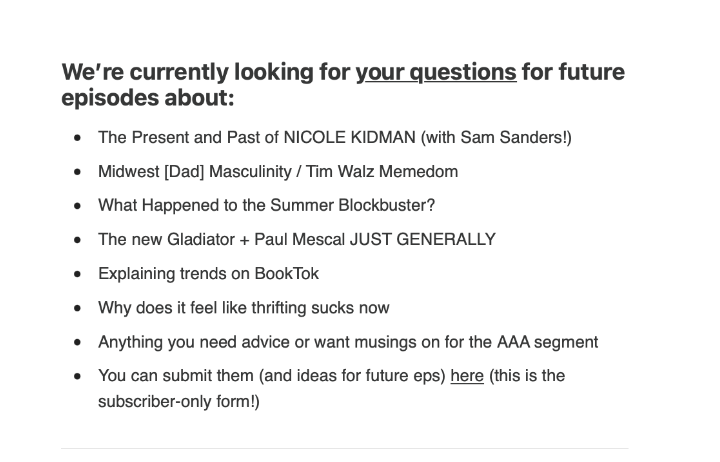
Feature testimonials, reviews, or social media highlights to create a sense of community and increase relevance.
Shout out a subscriber at the beginning of a newsletter or include a comment/positive review.
Reward your audience for referring a friend by shouting them out in your newsletter, offering a discount or free access to paid products, or sending them free merch.
Run a poll about your topic including both multiple-choice and open-ended answers. Run the best responses in the newsletter alongside your own commentary.
Offer more flexible subscription options
Inbox service providers (ISPs) use a lot of different factors to decide whether to send your email to recipients’ primary or spam folders. Their formulas are famously opaque, but one factor is (mostly) under your control: engagement.
ISPs use your newsletter’s open and click rates, as well as your audience’s clicking and scrolling behaviors, to judge whether your audience thinks your emails are legitimate and helpful.
So from a deliverability perspective, you’d rather have someone receive your emails only once per week, but click every time, than to have someone receive your emails every day but only click through 20% of the time.
People most often unsubscribe from emails when they think they’re getting too many irrelevant emails. But if they can receive fewer, but more relevant, messages, they’re more likely to stay subscribed and keep engaging.
So on your preference pages, give your audience more ways to control their sending frequency. Or give them the option to swap out an email for another piece of content — like a podcast episode or a case study.
Use multi-dimensional segments to create more thoughtful subscriber experiences
The best newsletters don’t just segment by behavior and purchase history. They’re using specific segments — like location, engagement level, interest, etc. — to create more relevant, effective customer journeys for every person in their audience. Here’s how to do it:
Localize your offerings: We’re seeing more publishers and newsletter operators use in-person events to create community among their audience members and bring their offering to life. Segmenting by location will make it easier to plan and promote these events. So ask your audience for their location in your sign-up flow. Then identify readers in a particular city to inform them about an in-person event you’re running near them.
Create a more curated welcome series: Many newsletters will welcome new subscribers with a series of 3-5 emails, which introduce the reader to the whole slate of their brand’s content. But if you’re running a general focus newsletter, these campaigns run the risk of being too broad or too self-promotional..
Instead, consider creating multiple welcome series corresponding to common interests or preferred content formats.
Say that you run a newsletter covering media industry news, focusing specifically on building sustainable media businesses and broad industry coverage.
In this case, you’d create two welcome series — one featuring case studies and webinars from leading media businesses and another one featuring original reporting of the media industry as a whole. This gives everyone in your audience the content that’ll keep them engaged long after the first email.
How to do it: On your sign-up form, ask audience members to check off their preferences. For best results, use a form builder that connects directly to your database, so that each person’s preferences are automatically added to their audience profile, and they’re placed in a segment corresponding to those preferences (following the example above, someone interested in media industry coverage would be added to a “news” segment). Then create two welcome series featuring relevant content for each of these segments.
Reward your most loyal subscribers: Query your audience for your most engaged subscribers, whether that’s by open and click rate, the length of time they’ve been subscribed, the amount of times they reply to your newsletter, etc. Send premium content — like podcast episodes or reports — early. Or you could even create specific assets just for this audience. For best results, surprise your VIPs with these extras about once a quarter.
Personalize emails based on the subscriber’s lifecycle stage — whether they’re new, active, or long-time readers: Tailoring content to where they are in their journey ensures relevance and reduces fatigue.
Use content recommendations to personalize at scale
Segmentation has its limits, though. No matter how many filters you mix and match, segments still can’t fully personalize to the individual. (The most famous example: King Charles and Ozzie Osbourne. They’re both globally renowned Brits born in 1948. But imagine addressing the King of England the way you would the lead singer from Black Sabbath).
But to prevent subscriber fatigue, you need to be that precise. That’s where dynamic content comes in: Each recipient gets email content based on their unique engagement and purchase history.
For best results, use content recommendations in your re-engagement emails. That way, every subscriber gets exactly the message they need to reconvert. That’s what Endeavor Business Media did in 2024, and it’s helped them reactivate more than 150,000 subscribers and counting. (See how they did it here!)
Capture richer audience feedback by using expanded survey formats
Surveys give you audience feedback straight from the source, so they’re one of the most cost-effective ways to drive first-party data.
But they’re not perfect: Time-consuming year-end surveys are naturally vulnerable to self-selection bias — your most highly engaged audience members are most likely to open and respond, which skews your data and keeps you from getting important critical feedback.
They’re also subject to survivor bias — you’re not going to hear from that person who unsubscribed 8 months ago.
Conducting surveys once or twice per year also means you’re missing a lot of insights: Almost nobody’s going to remember your newsletter from seven months ago, even if they liked it enough to share with a friend.
So in addition to year-end surveys, include mini-surveys in your emails to get a more consistent flow of feedback. Here’s how to do it:
Incorporate flash surveys within individual content blocks to see how your audience responds to individual topics: You can use the click data for individual articles to approximate your audience’s level of interest in particular topics. “70% of the audience clicked on our article about election security, so 70% of our audience must be interested in election security,” as the logic goes.
But clicks aren’t perfect indicators of someone’s interest: Maybe everyone clicked that article because it was listed on the top of the newsletter instead of the bottom. Or because your star reporter wrote the piece, or because you had a good headline, etc.
More importantly, the number of clicks doesn’t necessarily tell you why someone clicked, or how they feel about the topic, both of which you need to create a well-rounded content strategy.
The solution: Include one-question surveys within individual content blocks to gauge audience sentiment about individual topics. For instance, The DONUT, a nonpartisan news newsletter for the Gen Z set, ended its section on election integrity with a one-question poll asking viewers how confident they were in American election security.
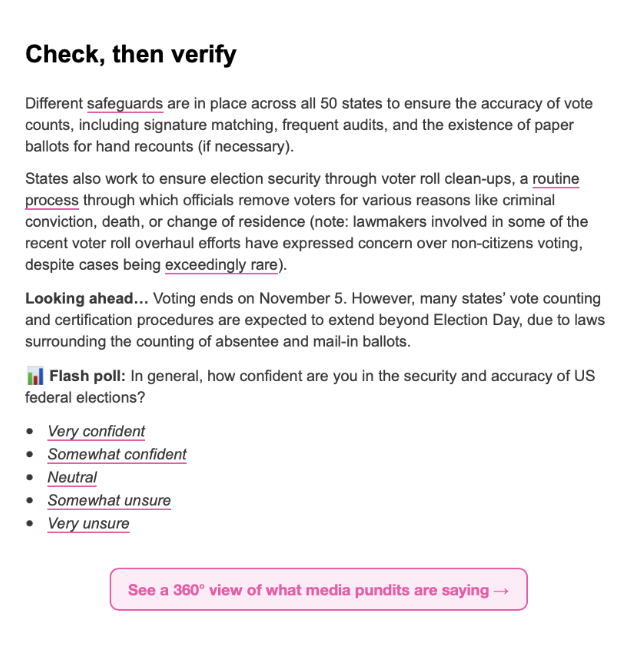
Clicking a response led to a Google form, where audience members can add an open-ended response that might appear in a future newsletter. This doesn’t just make it easier for readers to provide feedback. It tells the DONUT team how their audience feels, something they’d never be able to fully capture through pure behavioral data.
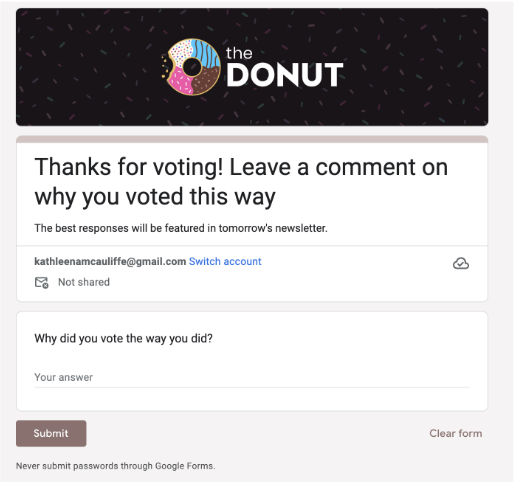
Bonus: You can also use the responses to lend additional context and spark conversations in subsequent issues, like The DONUT does below:
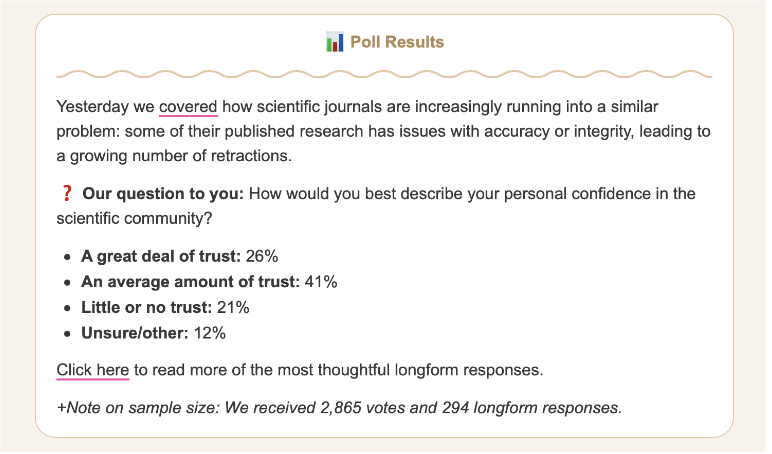
Include one-question surveys at the end of each newsletter: Include mini-surveys at the end of individual newsletters to capture and synthesize feedback in real time. This can consist of a single general satisfaction question, like Every includes at the bottom of its issues.
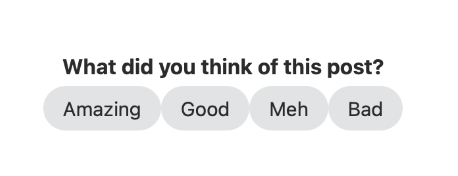
The one-click format makes it easier for any reader to respond, so you’re not as dependent on die-hard audience members taking the time to respond to your year-end surveys.
Regularly including surveys also gives you a more consistent, granular flow of information. So you can see how individual topics resonate with your audience — and stop unsubscribes before they start.
Create more responsive automations with campaign planning tools and fatigue filters.
The #1 reason people unsubscribe from newsletters? Getting too many emails that don’t feel relevant. But sometimes, your audience doesn’t want to completely unsubscribe. They just need a break for a few days or weeks.
That’s where campaign planning tools like fatigue filters can help you prevent churn. Here’s how they work:
Say that you’re running a weekly 4-email welcome series for your new subscribers, but Bill is already subscribed to two of your weekly newsletters.
You need Bill to have all the necessary onboarding information for newsletter #2, but you don’t want to overwhelm him, either. In this case, you might use a fatigue filter to temporarily stop sending one of your other newsletters to Bill until the welcome series ends.
Omeda makes this kind of responsiveness easy: On Omeda, you can use the fatigue filter to temporarily pause sending to recipients that have already gotten a certain number of emails from you within a specific time period (for example, anyone that got 3 emails in the last week will not receive the next email in the series until next week).
This way, you can space out your communications according to each individual’s needs without manually configuring the sending cadence for each one.
Complement email with other marketing channels
Spreading your marketing message over multiple channels increases the odds that you’ll reach and convert them in any one place.
So if your email performance has plateaued, and you’re following the best sending practices we mentioned above, consider replacing some of your email with other types of messages, like SMS messages, website personalizations, retargeting and more.
Maybe you’re running a 4-email renewal campaign. You might send one of those messages via SMS rather than email. (Pst: That’s why we added SMS to workflows on Omeda. Find more media-specific use cases for SMS marketing here.) Or you could use a website personalization to guide website visitors toward a renewal. Or you could send four emails, but use direct mail to grab your audience’s attention to catch your audience in a new place.
This strategy has its limits: If you’re running newsletter ads, you might not be able to sacrifice the impressions you’d lose from switching to SMS. But experimenting with new channels gives you new ways to grow, engage and activate your audience — and you could be surprised by what you find!
Performance by deployment type
Deployment type performance breakdown
Events
(Includes events, live conferences, virtual conferences and webinars)
- Unique open rate: 26.28%, up from 25.95% in Q2 2024 (+1.27% relative, +0.33% absolute)
- Unique click rate: 0.47%, down from 0.70% (-32.86% relative, -0.23% absolute)
- Unique CTR: 1.78%, down from 2.68% (-33.58% relative, -0.90% absolute)
Misc Comms
(Includes any communications that don’t fit into the other deployment categories)
- Unique open rate: 30.82%, no change from 30.83% in Q2 2024
- Unique click rate: 0.73%, down from 1.06% (-31.13% relative, -0.33% absolute)
- Unique CTR: 2.36%, down from 3.45% (-31.59% relative, -1.09% absolute)
Surveys & Research
(Includes reader service, research and surveys)
- Unique open rate: 25.57%, down from 27.49% (-6.98% relative, -1.92% absolute)
- Unique click rate: 0.66%, no change from 0.65%
- Unique CTR: 2.58%, up from 2.37% (+8.86% relative, +0.21% absolute)
Newsletters
(Includes digital magazines and newsletters)
- Unique open rate: 31.21%, slightly up from 31.15% (+0.19% relative, +0.06% absolute)
- Unique click rate: 1.86%, down from 2.00% (-7.00% relative, -0.14% absolute)
- Unique CTR: 5.96%, down from 6.42% (-7.17% relative, -0.46% absolute)
Promotions
(Includes advertiser promotion, audience promotion, marketing, third-party and white papers)
- Unique open rate: 29.73%, slightly down from 29.84% (-0.37% relative, -0.11% absolute)
- Unique click rate: 0.56%, down from 0.85% (-34.12% relative, -0.29% absolute)
- Unique CTR: 1.88%, down from 2.86% (-34.27% relative,-0.98% absolute)
White papers
- Unique open rate: 32.93%, slightly up from 32.39% (-1.67% relative, 0.54% absolute)
- Unique click rate: 0.62%, down from 0.72% (-13.89% relative, -0.10% absolute)
- Unique CTR: 1.88%, down from 2.23% (-15.70% relative, -0.35% absolute)
Third-party
- Unique open rate: 29.35%, down from 29.94% (-1.97% relative, -0.56% absolute)
- Unique click rate: 0.56%, down from 0.97% (-42.47% relative, -0.41% absolute)
- Unique CTR: 1.90%, down from 3.25% (-41.54%, -1.35% absolute)
All other promotional subcategories (advertiser promotion, audience promotion and marketing subcategories)
- Unique open rate: 29.62%, slightly down from 29.57% (-0.17% relative, -0.05% absolute)
- Unique click rate: 0.56%, down from 0.83% (-32.53% relative, -0.27% absolute)
- Unique CTR: 1.88%, down from 2.81% (-33.10% relative, down from 2.25%)
Struggling with siloed subscriber data, complicated workflows, and declining audience engagement? What if you could unify your subscriber data and use it to engage and convert your audience with less effort? Discover how Omeda’s integrated Audience Data Platform helps teams like yours use their subscriber data to strengthen their media businesses.